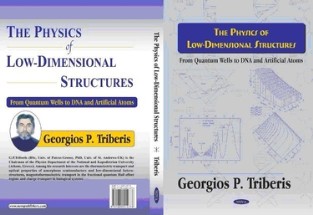G . P. TRIBERIS HOME PAGE
BOOKS_1
BOOKS
The Physics of Low-Dimensional Structures:
From Quantum Wells to DNA and Atrificial Atoms
Author: Georgios P. Triberis (Nova Science Publ. Inc., N.Y. 2007)
Table of Contents
Introduction
1. Quantum Wells
2. Quantum Wires
3. Near-Field Magnetoabsorption of Quantum Dots
4. Transport in the Fractional QHE Regime
Bibliography
Book Description
This book covers the field of low dimensional structures, starting from the selectively doped double heterostructures n-A1GaAs/GaAs/n-A1GaAs, and (strained) p-Si/SiGe/p-Si (quantum wells). The behavior of the sheet electron density, the subband populations and energies as a function of the well width, the spacer thickness and the doping concentration is analyzed. The temperature dependence of the bulk electron concentration versus the quasi-2DEG are discussed. In the framework of Boltzmann's transport theory a detailed study of the mobility is presented at low and high temperatures taking into account all the relevant scattering mechanisms.
The pseudomorphic Si/SiGe undoped quantum wells are a perfect example for the study of the non-parabolicity of the hole-bands. For the first time in a book an exact solution of the multiband effective mass equation that describes the heavy, light and split-off hole valence bands is introduced, and interband transitions and selection nrules are obtained.
Reducing dimensionality new aspects concerning optical and transport properties of quantum wires (QWRS) is discussed. Specifically, the photoluminescence and the microphotoluminescence spectra of V-shaped QWRS is theoretically interpreted leading to a realistic cartography of the interface roughness of these systems. A computational approach for the solution of the eigenvalue problem in low-dimensional systems of complex but realistic geometry is also presented for the first time in a book, and transport theoretical considerations will lead to a systematic study of the mobility.
As DNA could be considered as a one-dimensional "molecular wire" the study of carrier transport along DNA is discussed in terms of hopping transport.
A computational scheme is presented which allows the study of near-field magnetoabsorpsion spectra of Quantum Dots (QD) of any given geometry, under magnetic field of any orientation. The effect of the spatial confinement imposed by the QD dimensions and the magnetic confinement governed by the magnetic field are explored. The influence of the Coulomb interactions between electrons and holes is also discussed. The applicability of the method in actual experiments, i.e. the illumination of a nanostructure with a near-field probe in conjunction with the simultaneous application of an external magnetic field, may become a challenge to experimentalists. Finally, magnetothermoelectic transport in the fractional quantum Hall effect (FQHE) regime is discussed. The theoretical framework for the calculation of the resistivity, the thermopower and the thermal conductivity for two-dimensional electron and hole gases, at low temperatures and strong perpendicular magnetic fields is outlined. The composite fermion picture enables the use of the integer quantum Hall effect and Shubnikov - de Haas conductivity models for a quantitative comparison with experiment. A study on the validity of fundamental physical laws such as the Wiedemann-Franz law in two-dimensional structures is also presented.
